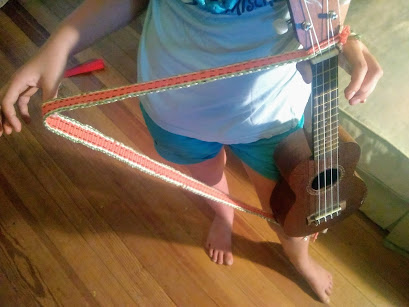I like my band looms better than Tablets. It is so much faster to warp, weave and follow.
 |
| Roger making Ale Bowls |
But, a few years ago, Roger and I started demonstrating at the Hjemkomst & Midwest Viking Festival
in Moorhead, MN. Roger was hired to demonstrate bowl turning on his foot lathe. He had worked on a project with the Smithsonian and had a good outfit and of course his homemade equipment and tent. I went along for the ride, quickly made a couple of inacurate dresses, brought along some "Saxon" pottery, and sat down to weave on my band loom. I would discuss with visitors and fellow weavers the history of weaving bands in Viking times and speculate on when Scandinavia adopted the band loom.
 |
| An old Scandinavian Band Loom |
History is sometimes hard to research. The official Viking period is listed as from 793 through 1066. There are a few objects found for textiles. Among these are the thin bands of cloth used for tying clothing, bags and tools, mending, and of course, decorations on clothing.
 |
| Tablet bands possibly using all 2 holes |
I was excited to find this plain band decoration on some clothing that looked a lot like my band weaving on the little rigid heddles. I started searching facebook groups to find more knowledgeable people that could tell me about the structure of the weave. This plain band looked more like a band weaving than the popular Tablet weaving you see everyone demonstrating. The fancy bands using 4 holes on a tablet card creates wonderful bands that we all love. Everyone I talked to insisted Vikings were not using the rigid band loom, they used tablets.
 |
| Fancy Tablet bands using all 4 holes |
Finally, someone posted to me that the pattern on the piece I found was created by using only two holes of the tablet. When twisted two quarter turns forward and weft placed in that shed, turned two quarter turns backwards for the next shed and so on will create the simple pattern.
I then remembered the first book I found on band weaving when I started out weaving 20 years ago. It was a book I found on Ebay called BAND published in 1958, written by Liz Trotzig. It's in Swedish! There are a lot of photos and soon with the help of Google Translater I learned the basic terms.
Twenty years ago, people in New England had forgotten Band Weaving. We have lots of old looms in our museums and living history sites. New England, settled by the English, used paddle and box looms. But no one was demonstrating. No one was interested in working them anymore. Even our Amish in nearby Pennsylvania thought that it was easier to by factory made ribbons than make their own. In the 1940s, Mary Atwater, after a visit abroad, came up with the modern "inkle" loom, a cut-down version of a Swedish floor model. (Inkle means a thin piece of fabric).
 |
| 1800s paddle tape loom |
 |
| English box loom |
 |
| Inkle loom |
I remember I had one of these Inkle looms in the 70s. Hippies like me, had revived the craft, making belts and guitar straps. They were wonderful. And then the craft died down again. In the past 20 years more people have revived Band weaving. There are now many wonderful books on patterns and uses for the Bands.
My Swedish BAND book has good directions and patterns for the rigid heddle types of looms. In the back of the book, there are a few pages devoted to Tablets. I had forgotten this in my quest for bands, and sure enough, there were instructions on setting up two hole tablets.
Vikings would have used linen or wool fibers. I did a sample in my linen/cotton thread using two holes in each card. And there it was. I wove the same pattern with embroidery floss so I could see the structure better. I wove a wider piece using Jute to use as plain ties for hanging tools, etc. I tried a wider linen band, and a narrow band using only 8 threads of some 8/2 linen to make a quarter inch band for ties.
 |
| Two hole set up |
 |
| Top band linen/cotton... bottom band embroidery floss |
 |
| Jute and Linen bands using 2 hole Tablet |
I started my quest for two-hole tablet weaving last year. And now in April, in the Big Shutdown, I need to talk to my tablet weaver friends back in the Mid-west to get some tips and discuss this project. But I can't. So I have decided to write this and post this and to glean more information and comments from other weavers.
I had planned to bring this plain band, two hole project to Moorhead MN at this years Viking festival. This is planned for June 26-27. It has not been canceled yet. We are all still hoping to participate. I will be able to talk to some more experienced weavers. And it will be lots of fun.
http://www.cityofmoorhead.com/departments/parks-recreation/hjemkomst-center-special-events
For you newbies to my Blog, use the search button above and type in Bands or Tapes to find more projects for your bands, building your own simple loom and stories of my weaving adventures. New to Tape or Band weaving? Look up my beginners easy to use book Tape Loom Weaving... simplified on my web site www.eastknollpottery.com (yes, I am also a potter) or on Amazon.com. Subscribe to my blog to get notice on future projects and loom building or follow me on Facebook... Tape Loom Weaving.... and Happy Weaving!























































